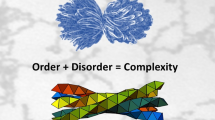Abstract
The strong dependence of cytotoxicity of Keggin heteropoly acids [XM12O40]n–, X = Si or P, M = Mo and W, n = 3 or 4 on chemical composition is demonstrated using the example of human embryo fibroblast cells based on the results of diagnostics using impedance monitoring, scanning electron microscopy, and measurements of visible cell sizes. The explanation of this dependence based on the role of hydrolytic stability of multiply charged anions in the development of cytotoxicity of these compounds is suggested. The results make it possible to suggest a new mechanism for the development of selectivity of polyoxometalate cytotoxicity relative to the studied cells. The differentiated cytotoxic activity of polyoxometalates relative to oncogenic cells is predicted.
Similar content being viewed by others
References
M. S. Pop, Heteropoly-and Isopolyoxometallates (Nauka, Novosibirsk, 1990) [in Russian].
D.-L. Long, E. Burkholder, and L. Cronin, “Polyoxometalate clusters, nanostructures, and materials: from self assembly to designer materials and devices,” Chem. Soc. Rev. 36, 105–121 (2007).
G. I. T. Cooper, P. I. Kitson, R. Winter, M. Zagnoni, D.-L. Long, and L. Cronin, “Modular redox-active inorganic chemical cells: ICHELLs,” Angew. Chem., Int. Ed. 50, 10373–10376 (2011).
D. Karimian, B. Yadollahi, and V. Mirkhani, “Dual functional hybrid-polyoxometalate as a new approach for multidrug delivery,” Microporous Mesoporous Mater. 247, 23–30 (2017).
W. Lu, Zh. Baibin, and L. Jiaren, “Anticancer polyoxometalates,” Prog. Chem. 25, 1131–1141 (2013).
J. T. Rhule, C. L. Hill, D. A. Judd, and R. F. Schinazi, “Polyoxometalates in medicine,” Chem. Rev. 98, 327–358 (1998).
S. Shigeta, S. Mori, T. Yamase, N. Yamamoto, and N. Yamamoto, “Anti-RNA virus. Activity of polyoxometalates,” Biomed. Pharmacother. 60, 211–219 (2006).
H. Yanagie, A. Ogata, S. Mitsui, T. Hisa, T. Yamase, and M. Eriguchi, “Anticancer activity of polyoxomolybdate,” Biomed. Pharmacother. 60, 349–352 (2006).
L. Wang, K. Yu, B.-B. Zhou, Z.-H. Su, S. Gao, L.-L. Chu, and J.-R. Liu, “The inhibitory effects of a new cobalt-based polyoxometalate on the growth of human cancer cells,” Dalton Trans. 43, 6070–6078 (2014).
L. Fu, H. Gao, M. Yan, S. Li, X. Li, Z. Dai, and S. Liu, “Polyoxometalate-based organic-inorganic hybrids as antitumor drugs,” Small 11, 2938–2945 (2015).
I. A. Suetina, M. V. Mezentseva, E. A. Gushchina, F. A. Lisitsin, L. I. Russu, O. A. Lopatina, E. L. Firsova, S. A. Kovalevskii, B. A. Budanov, F. I. Dalidchik, A. S. Seleznev, R. A. Morozov, and E. A. Gushchina, “Study of growth activity and viability of cultured human embryo fibroblasts under the influence of polyoxametalates,” Inform. Byull. Kletochn. Kul’tury, No. 31, 67–78 (2015).
O. A. Lopatina, O. V. Baklanova, I. A. Suetina, E. I. Isaeva, E. A. Gushchina, L. V. Russu, F. A. Lisitsin, S. A. Kovalevskii, B. A. Budanov, F. I. Dalichik, and M. V. Mezentseva, “Cytotoxic and antiviral effect of polyoxometalates in vitro experiments,” in Proceedings of the 22nd Russian National Congress on Human and Medicine, Moscow, 2015, p. 230.
O. A. Lopatina, O. V. Baklanova, I. A. Suetina, E. I. Isaeva, E. A. Gushchina, L. V. Russu, F. A. Lisitsin, S. A. Kovalevskii, B. A. Budanov, F. I. Dalichik, and M. V. Mezentseva, “Toxic effect of polyoxometalates (POMs) with Keggin’s structure on normal and tumor cells culture,” Biol. Radioelektron., No. 3, 42–49 (2015).
Q. Liu, C. Wu, H. Cai, N. Hu, J. Zhou, and P. Wang, “Cell-based biosensors and their application in biomedicine,” Chem. Rev. 114, 6423–6461 (2014).
F. Asphahani, M. Thein, K. Wang, D. Wood, S.-S. Wong, J. Xu, and M. Zhang, “Real-time characterization of cytotoxicity using single-cell impedance monitoring,” Analyst 137, 3011–3019 (2012).
J. Z. Xing, L. Zhu, J. A. Jackson, S. Gabos, X. J. Sun, X. B. Wang, and X. Xu, “Dynamic monitoring of cytotoxicity on microelectronic sensors,” Chem. Res. Toxicol. 18, 154–161 (2005).
R. A. Cardone, V. Casavola, and S. J. Reshkin, “The role of disturbed pH dynamics and the Na+/H+ exchanger in metastasis,” Nat. Rev. Cancer 5, 786–795 (2005).
M. Anderson, A. Moshnikova, D. M. Engelman, Y. Reshetnyak, and O. Andreev, “Probe for the measurement of cell surface pH in vivo and ex vivo,” Proc. Natl. Acad. Sci. U.S.A. 113, 8177–8181 (2016).
X. Lopez, J. A. Fernández, and J. M. Poblet, “Redox properties of polyoxometalates: new insights on the anion charge effect,” Dalton Trans., No. 9, 1162–1167 (2006).
M. H. Ross, L. J. Romrell, and G. I. Kaye, Histology—A Text and Atlas, 3rd ed. (Williams and Wilkins, Baltimore, 1995).
I. Holclajtner-Antunovi, V. Kunti, Z. Jurani, I. Filipovi, U. Mio, and T. Stanojkovi, “Study of some polyoxometalates of Keggin’s type as potential antitumor agents,” Jugoslav Med. Biohem. 23, 25–30 (2004).
Y. Liu, S. Tian, S. Liu, and E. Wang, “In vitro inhibitory effect of polyoxometalates on human tumor cells,” Transit. Met. Chem. 30, 113–117 (2005).
S. Dianat, S. Tangestaninejad, B. Yadollahi, A. K. Bordbar, M. Moghadam, V. Mirkhani, and I. Mohammadpoor-Baltork, “Stability investigation of some heteropolyoxotungstate and heteropolyoxomolybdate salts in buffer solutions,” J. Mol. Liq. 174, 76–79 (2012).
D. Bajuk-Bogdanovic, I. Holclajtner-Antunovic, M. Todorovic, U. Mio, and J. Zakrzewska, “A study of 12-tungstosilicic and 12-molybdophosphoric acids in solution,” J. Serb. Chem. Soc. 73, 197–209 (2008).
S. Harguindey, D. Stanciu, J. Devesab, K. Alfarouk, R. Cardone, J. Polo, P. Devesa, C. Rauch, G. Orive, E. Anitua, S. Roger, and S. Reshkin, “Cellular acidification as a new approach to cancer treatment and to the understanding and therapeutics of neurodegenerative diseases,” Seminars Cancer Biol. 43, 157–179 (2017).
Author information
Authors and Affiliations
Corresponding author
Additional information
Original Russian Text © S.A. Kovalevskii, O.A. Lopatina, F.I. Dalidchik, O.V. Baklanova, I.A. Suetina, L.I. Russu, E.A. Gushchina, E.I. Isaeva, M.V. Mezentseva, 2018, published in Rossiiskie Nanotekhnologii, 2018, Vol. 13, Nos. 7–8.
Rights and permissions
About this article
Cite this article
Kovalevskii, S.A., Lopatina, O.A., Dalidchik, F.I. et al. Effect of Keggin Heteropoly Acids on Human Embryo Fibroblast Cells. Nanotechnol Russia 13, 400–405 (2018). https://doi.org/10.1134/S1995078018040080
Received:
Accepted:
Published:
Issue Date:
DOI: https://doi.org/10.1134/S1995078018040080




